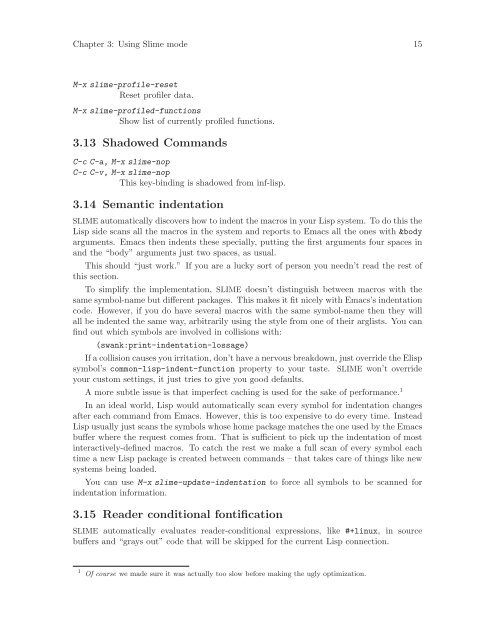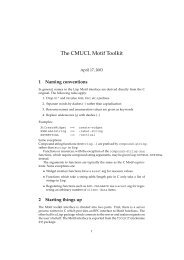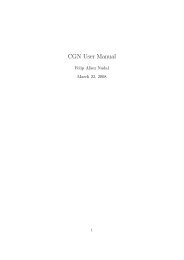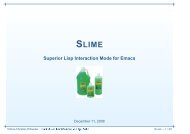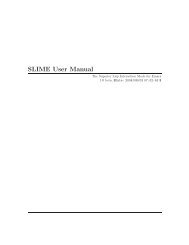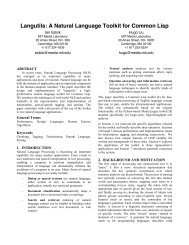SLIME User Manual version 3.0-alpha - Common Lisp
SLIME User Manual version 3.0-alpha - Common Lisp
SLIME User Manual version 3.0-alpha - Common Lisp
Create successful ePaper yourself
Turn your PDF publications into a flip-book with our unique Google optimized e-Paper software.
Chapter 3: Using Slime mode 15<br />
M-x slime-profile-reset<br />
Reset profiler data.<br />
M-x slime-profiled-functions<br />
Show list of currently profiled functions.<br />
3.13 Shadowed Commands<br />
C-c C-a, M-x slime-nop<br />
C-c C-v, M-x slime-nop<br />
This key-binding is shadowed from inf-lisp.<br />
3.14 Semantic indentation<br />
<strong>SLIME</strong> automatically discovers how to indent the macros in your <strong>Lisp</strong> system. To do this the<br />
<strong>Lisp</strong> side scans all the macros in the system and reports to Emacs all the ones with &body<br />
arguments. Emacs then indents these specially, putting the first arguments four spaces in<br />
and the “body” arguments just two spaces, as usual.<br />
This should “just work.” If you are a lucky sort of person you needn’t read the rest of<br />
this section.<br />
To simplify the implementation, <strong>SLIME</strong> doesn’t distinguish between macros with the<br />
same symbol-name but different packages. This makes it fit nicely with Emacs’s indentation<br />
code. However, if you do have several macros with the same symbol-name then they will<br />
all be indented the same way, arbitrarily using the style from one of their arglists. You can<br />
find out which symbols are involved in collisions with:<br />
(swank:print-indentation-lossage)<br />
If a collision causes you irritation, don’t have a nervous breakdown, just override the Elisp<br />
symbol’s common-lisp-indent-function property to your taste. <strong>SLIME</strong> won’t override<br />
your custom settings, it just tries to give you good defaults.<br />
A more subtle issue is that imperfect caching is used for the sake of performance. 1<br />
In an ideal world, <strong>Lisp</strong> would automatically scan every symbol for indentation changes<br />
after each command from Emacs. However, this is too expensive to do every time. Instead<br />
<strong>Lisp</strong> usually just scans the symbols whose home package matches the one used by the Emacs<br />
buffer where the request comes from. That is sufficient to pick up the indentation of most<br />
interactively-defined macros. To catch the rest we make a full scan of every symbol each<br />
time a new <strong>Lisp</strong> package is created between commands – that takes care of things like new<br />
systems being loaded.<br />
You can use M-x slime-update-indentation to force all symbols to be scanned for<br />
indentation information.<br />
3.15 Reader conditional fontification<br />
<strong>SLIME</strong> automatically evaluates reader-conditional expressions, like #+linux, in source<br />
buffers and “grays out” code that will be skipped for the current <strong>Lisp</strong> connection.<br />
1 Of course we made sure it was actually too slow before making the ugly optimization.


